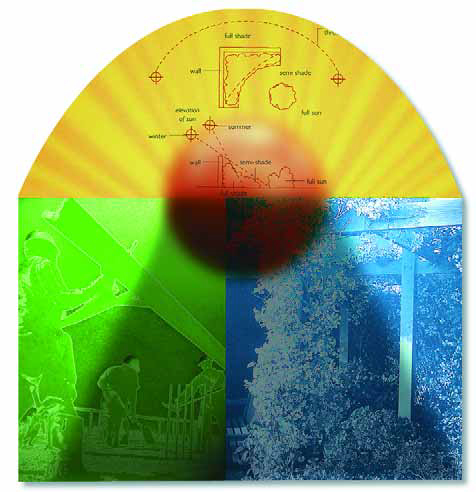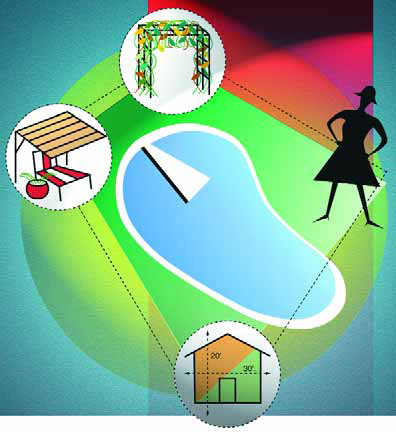engineering
I truly enjoy including shade structures in my designs. Whether I'm working with an overhang, an arbor, a loggia, a pergola or some other structure (and, yes, they are all different), I see them as ways to create visual extensions of a house - and wonderful places to enjoy being next to the water. There is, of course, as much art and skill to designing and installing the right shade structure as there is to setting up all of the other features of a great backyard. Done well, a structure that projects out from a house will pull your eye from inside to outside while it provides relief from the sun. Similarly, freestanding shade structures
LeRoy, N.Y., is an historic village that's most famous (or most notorious?) for being the birthplace of Jell-O. Far more significant to me, however, is the fact that the town is filled with beautiful 19th-century homes that run the architectural gamut from Colonial to Italianate to Victorian in style. It's a beautiful place, and the site of one of my firm's most unusual projects in recent memory. The home featured in this article is a Second Empire Italianate estimated to be about 140 years old. It's a prime example of 19th-century craftsmanship, from the Mansard roof with its scrolled cornices to the drive-through porte-cochere and the wraparound porch with its beefy wood railings. It's definitely an architectural treasure, filled with the kinds of details that have been lost as far as today's custom-built homes are concerned. Mindful of those special touches, we set about designing a similar level of detail into the landscaping in creating gardens and watershapes that brought real tranquility to
In the ballet of sequenced water, you'll find a repertoire of effects for watershapes of all kinds. Like individual dance steps, these water effects can be beautiful on their own - or they can be used in combination with other effects to create elaborately choreographed shows that dazzle, delight and entertain. From simple to complex and from small to utterly huge, sequenced-water effects are truly amazing, and the nice thing is that they can be incorporated into all kinds of watershapes. We'll take a look at some of the possibilities here as a means of defining why you and your clients should think about incorporating the devices needed to make them work in your projects. There are practical issues, of course, so we'll also cover the process of designing for sequencing and the considerations involved in the creative effort, as well as discussing the ins and outs of programming and commissioning for sequenced watershapes. In an extensive sidebar, we'll also take a look at available technologies and their strengths and weaknesses. Before we get into
Looking for inspiration in an urban environment can leave a designer with precious few useful references. Take downtown Chicago, for example, where our indigenous waterfeature is Lake Michigan and our public art is too often plopped in the middle of concrete plazas. Be that as it may, I do my part by trying to introduce both water and art into my projects. So I was thrilled to be retained by Mary O'Shaughnessy, owner of the Wood Street Gallery in Chicago, to design a sculpture garden. I knew it would give me the chance to create a balanced, beautiful space - even though I also knew the job wouldn't be easy. What she wanted was a garden environment in which she could display and sell contemporary American sculpture - a place that would help clients visualize the way the art might look in their own gardens. As we dug deeper, we uncovered additional goals: It needed to be a space that would accommodate a changing variety and number of pieces; it had to be functional for large parties; and it had to incorporate and acknowledge the garden's urban neighborhood while still providing a sense of enclosure for gallery visitors (and, of course,
Contrary to the impression that might be given by the headline, this isn't an article about building arbors that are safe. Rather, it's about how you can protect your clients and their guests from the sun by building beautiful structures in their yards. (Safety is part of the discussion, too, but not its focus.) I bring this up because many clients put piles of money into building spectacular pools but fail to give much thought to their surroundings. That's a shame, because those surroundings almost certainly will be seen much more than the pools will be used in the course of the average year. Several things need to be
In February 1999, the cover photo on the premiere issue of WaterShapes showed a steel cage for a subgrade piling being lowered into the ground. That image was taken from a feature article by designer/builder David Tisherman, the first of many that he has contributed to the magazine. In that article and in another that followed in April 1999, he detailed the design and construction of an elaborate residential swimming pool project that he
An important part of creating a human environment in harmony with nature is planning for and designing with the cycle of the seasons in mind. At our company, the Dirsmith Group, we operate with the belief that a blending of fine architecture and landscape design into our natural environment, in careful harmony with human beings, demonstrates both a reverence and a respect for nature. The result of this blended environment is that people feel good: They enjoy being in the space, and we believe it enriches the human spirit. When it comes to working with the seasons specifically, that's easier said than done in
It's natural for me to wax poetic about my work. Gardening and garden designs are what I call my "magnificent obsession" - so much so that the other arts in which I have an interest and for which I even have talent will generally take a back seat. After more than 19 years as a professional landscape designer, I am still driven and excited by the challenge of creating comprehensive landscapes for my clients. I thrive on the complexity of organizing the myriad elements required to create outdoor spaces that function properly, are beautiful and harmonious to the eye - and even touch
Of all the sports, there's none that relies more on the art of landscaping than golf. The contours of the land, the style, size and placement of plantings, the use of elaborate stonework and the installation of substantial bodies of water often define not only the competitive challenge of the game but the ambiance and character of the entire golfing experience. This is especially true of championship golf courses, where designers seek ways to stretch the envelope in terms of the way the game is played and in the physical beauty of the courses themselves. In their search for true distinction, many have turned to the use of






















